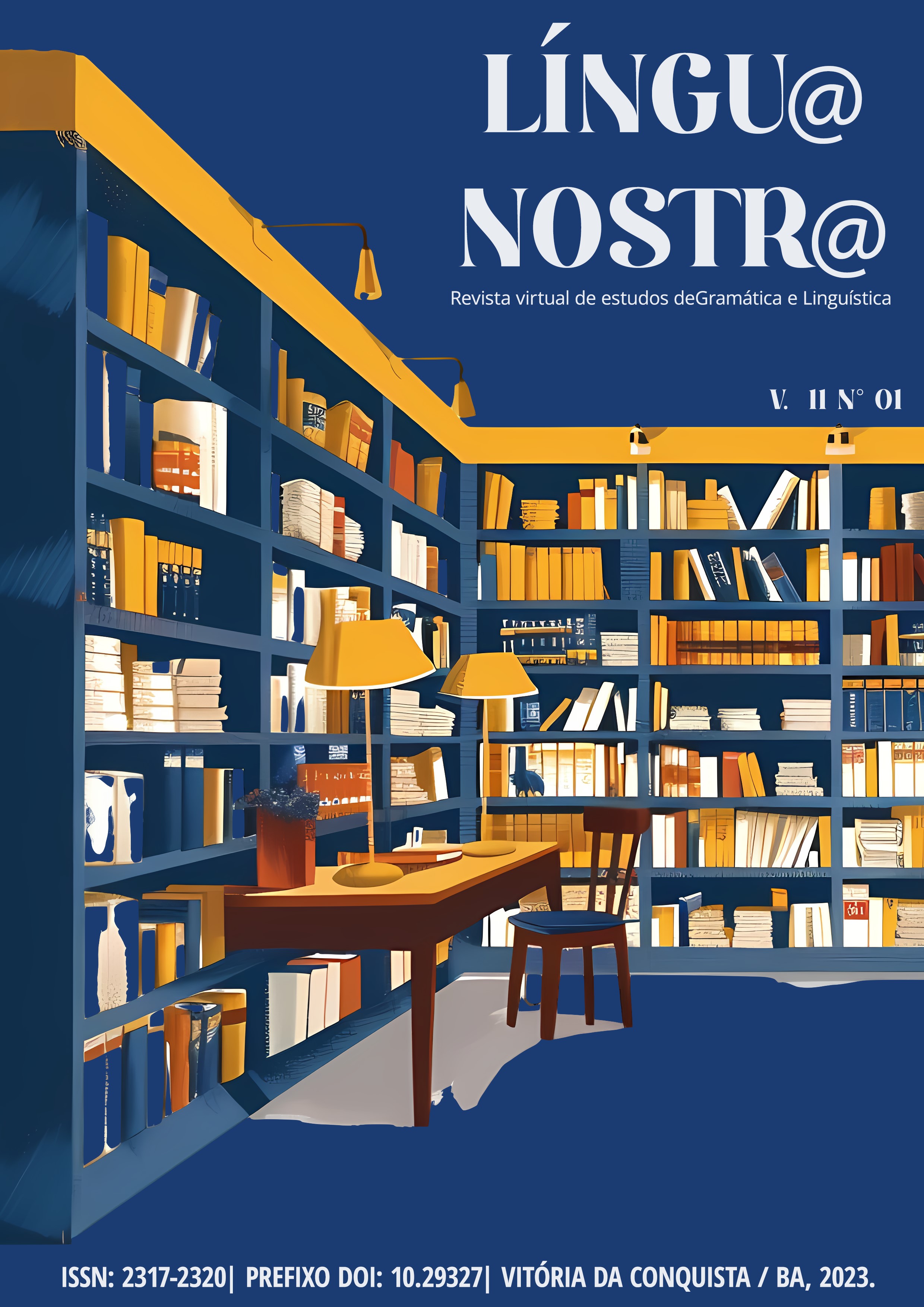INTERTEXTUALITY, MULTIMODALITY AND CONTEX-TO: A PRO-POSAL FOR READING COMPREHENSION FROM THE PERSPEC-TIVE OF TEXTUAL LINGUISTICS
DOI:
https://doi.org/10.22481/lnostra.v11i1.14115Keywords:
Context, Intertext, Reading, Multimodality, TextAbstract
The present article is inscribed in the area of Textual Linguistics and brings the concepts of intertext, context and multimodality. In this sense, the following question remains: in what way do these concepts contribute to a reading proposal from the perspective of textual linguistics? In view of this, we elected as our main goal to conduct a study about these concepts and promote the application of a reading proposal based on a cover of the newspaper “O Estado de Minas” published in a digital support. To reach the objectives, we opted for an expanded reading in which textual resources are mobilized for the analysis, by means of a bibliographic review. The interpretation of the collected material, will follow the concepts of text, intertext and context of Beaugrande (1997), Cavalcante, Oliveira (2019), Elias, Cavalcante, (2017) Koch, Elias, (2016); Koch (2005) and multimodality of Kress and van Leeuwen (2006 [1996]). Assuming that reading is a powerful strategy when it dialogues with the needs and urgencies of the knowledge construction process, by approaching the text in a way that considers the aforementioned concepts, we hope to reflect the reading process beyond the textual to the construction of knowledge
Downloads
References
Referências
BAKHTIN, Mikhail. Estética da criação verbal. trad. Paulo Bezerra. São Paulo, 1979.
BEAUGRANDE, Robert de. (1997) New foundations for a science of text and dis-course: cognition, communication and freedom of access to knowledge and soci-ety. Norwood, New Jersey, Ablex Publishing Corporation.
BRASIL. Base Nacional Comum Curricular (BNCC). Educação é a Base. Brasília,
MEC/CONSED/UNDIME,2018.Disponívelem:<http://basenacionalcomum.mec.gov.br/images/BNCC_EI_EF_110518_versaofinal_site.pdf>. Acesso em 12 dezem 2020.
_______. Secretaria de Educação Básica. Parâmetros curriculares nacionais: ensi-no médio: linguagens, códigos e suas tecnologias. Secretaria de Educação Básica. Brasília: MEC/SEB, 2000.
_______. Secretaria de Educação Básica. Parâmetros curriculares nacionais: ensi-no médio +: Orientações Educacionais Complementares. Secretaria de Educação Básica. Brasília: MEC/SEB,2002.
_______. Secretaria de Educação Básica. Orientações curriculares para o ensino médio: linguagens, códigos e suas tecnologias. Secretaria de Educação Básica. Brasília: MEC/SEB, v.1, 2006.
CAVALCANTE, Mônica Magalhães; CUSTÓDIO FILHO, Valdinar. Revisitando o esta-tuto do texto. Revista do GELNE, v. 12, n. 2, p. 56-71, 2010.
ELIAS, Vanda Maria Da Silva. Hipertexto, leitura e sentido. Calidoscópio, v. 3, n. 1, p. 13-19, 2005.
FÁVERO, Leonor L.; KOCH, Ingedore Villaça. Introdução a Linguística Textual. 1994
KOCH, Ingedore Villaça. A coesão textual. 10ª ed. São Paulo: Contexto, 1989.
KOCH, Ingedore Villaça; ELIAS, V. TRAVAGLIA, Luiz C. Texto e coerência, v. 4, 1992.
KOCH, Ingedore G. Villaça. 2) Linguagem e cognição: a construção e reconstrução de objetos-de-discurso. Veredas-revista de estudos linguísticos, v. 6, n. 1-, 2002.
KOCH, Ingedore. Villaça. A interação pela linguagem. São Paulo: Contexto, 2003.
KOCH, Ingedore Grunfeld Villaça. Argumentação e linguagem. 13. ed. São Paulo: Cortez, 2011.
KOCH, Ingedore G. Villaça; ELIAS, Vanda Miranda. Fala e escrita. Ler e escrever: estratégias de produção textual, v. 2, p. 29-73, 2015.
KOCH, Ingedore G. Villaça; ELIAS, Vanda Maria. O texto na linguística textual. O tex-to e seus conceitos. São Paulo: Parábola Editorial, p. 31, 2016.
KRESS; Gunther; VAN LEEUWEN, Theo. Reading images: The grammar of visual design. 2 ed. London: Routledge, 2006.
KRISTEVA, Julia. Introdução à Semanálise. Tradução: Lúcia Helena França Fer-raz.São Paulo: Perspectiva, 1974.
MAINGUENEAU, Dominique. Análise de textos de comunicação. ampl. 2013.
ROJO, Roxane. O letramento escolar e os textos da divulgação científica-a apro-priação dos gêneros de discurso na escola. Linguagem em (Dis) curso, v. 8, n. 3, p. 581-612, 2008.
ROJO, Roxane. Novos multiletramentos e protótipos de ensino: por um web-currículo. In:CORDEIRO, G. S.; BARROS, E. M. D.; GONÇALVES, A. V. (Orgs.) Letra-mentos, objetos e instrumentos de ensino: gêneros textuais, sequências e gestos didá-ticos. Campinas: Pontes, 2017, p. 189-216.
ROJO, Roxane. MOURA. Eduardo. Letramentos, mídias, linguagens. São Paulo: Parábola, 2019.
SANTOS, E. P. DOS. A intertextualidade na construção argumentativa do artigo de opinião. Diálogo da Letras, v. 2, n. 1, p. 300-314, 13 mar. 2001.
SANTOS, Záira Bomfante; PIMENTA, Sônia Maria Oliveira. Da semiótica social à multi-modalidade: a orquestração de significados. Casa: Cadernos de Semiótica Aplicada, v. 12, n. 2, p. 295-324, 2014. (SANTOS; PIMENTA, 2014, p. 321).
Downloads
Published
How to Cite
Issue
Section
License
Copyright (c) 2024 Língu@ Nostr@

This work is licensed under a Creative Commons Attribution 4.0 International License.






